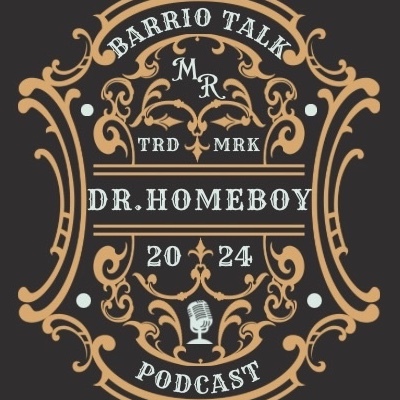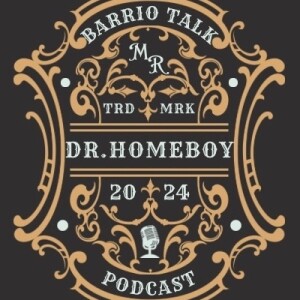Welcome to the Dr. Homeboy Podcast, hosted by Marco Antonio Romero, also known as Dr. Homeboy. In this episode, we delve into the history and education surrounding gang involvement, with a focus on low-income Mexican American communities. This episode, titled "History and Education" or "Clecha," provides educational and historical content to offer hope and alternative paths for the youth.
Dr. Homeboy discusses the systemic educational disparities that contribute to gang involvement, tracing back to the inception of the United States. The episode covers the historical background of these disparities, the impact of gangs on communities, and the theories that inform Dr. Homeboy's work. These theories, including humanistic theory, critical race theory, and the cognitive theory of multimedia learning, have practical implications that can be applied to real-life situations.
Listeners will gain insight into the complexities of educational inequalities, the formation and influence of gangs, and the importance of addressing these issues holistically. Tune in to learn more about the power of education, the systemic challenges marginalized communities face, and how we can work towards a brighter future.
Remember to like, comment, and subscribe to the Dr. Homeboy Podcast for more educational content and to share your thoughts and stories. Your active participation is encouraged and valued. Join us for the next episode as Dr. Homeboy shares his personal journey and positionality statement.
Annotated Outline
Episode Introduction
The episode begins with an engaging music interlude and sound effects that capture the listener’s attention and set the ambiance for the podcast.
Greet and introduce the podcast's title and host's name.
Provide disclosure.
Call to action: Audience engagement.
Talking Point 1
Introduce the title of the episode and what will be covered.
The issue at hand is gang involvement, which will be explored in more depth.
The historical background of educational disparities.
The history of gangs and their impact on our youth and our communities.
The detailed description of theories previously described in episode one is the humanistic theory, critical race theory (CRT), and the cognitive theory of multimedia learning (CTML).
Marco Antonio Romero begins by introducing the episode’s title, “The History and Education of Gang Involvement and Educational Disparities.” He then discusses the issue at hand, gang involvement (Lochner & Moretti, 2004). He then delves into the topic in more depth, as these go hand in hand and a sequential and detrimental effect with the issues that affect the teenage Mexican American male population that leads them to gang involvement (Lochner & Moretti, 2004).
Additionally, he discusses other components of the episode that will be covered. He will provide a historical background of educational disparities and gangs and their impact on our youth and our communities. Lastly, he will provide a detailed description of the theories previously introduced in episode one: humanistic theory, critical race theory (CRT), and the cognitive theory of multimedia learning (CTML).
Talking Point 2
Provide a history of educational disparities.
Provide the history of gangs and their impact on this population, their community, our country, and the world.
Define, describe, and cover the history of the theories that this podcast is grounded on.
Humanistic theory.
Critical race theory (CRT).
The cognitive theory of multimedia learning.
Marco Antonio Romero provides a history of educational disparities, such as the 14th Amendment, which was signed into law in 1868 (Consitution Annotated, n.d.). Additionally, Plessy v. Ferguson was signed into law in 1896(National Archives, 2022). Lastly, Brown versus the Board of Education, which was signed into law in 1954 (National Archives, 2021).
Additionally, Marco Antonio Romero provides a history of gangs and their impact on teenage Mexican American males, our communities as a whole, and throughout the world (Maguire, 1999; Sullivan & Logan, 2010; Weide, 2020). He does so by providing the beginning of gangs in the United States, which can be traced back to 1783 (Flores, 2016). Furthermore, the formation of gangs in California for protection dates back to the 1940s (Flores, 2016). Lastly, when gangs in California began to spread (Flores, 2016).
Moreover, Marco Antonio Romero provides a detailed description of the theories that were previously introduced in episode one: humanistic theory, critical race theory (CRT), and the cognitive theory of multimedia learning (CTML). He chose humanistic theory because of it being holistic and how it addresses all the needs of an individual (Winston, 2016); as such, he delves into the theory. Additionally, he chose to utilize critical race theory (CRT) because it is a starting point for addressing specificity; it paved the way for intersectionality and created umbrellas of CRT, such as Latino and Latina critical legal theory (LatCrit) that begin to address specificity (Delgado et al., 2023), as such he delves into the theory. Lastly, he chose the cognitive theory of multimedia learning (CTML) because it provides an array of information through different mediums, such as audio and visual. It can be accessed at any time and when needed; it is also discrete and confidential, which is crucial to the teenage Mexican American male population (McNamara & Drew, 2019).
Talking Point 3
Recap of the episode and key takeaways.
Call to action.
Final words.
Exit the episode with an engaging music interlude and sound effects that capture the listener’s attention and exit the podcast, leaving them wanting to tune back in next time.
References
Acevedo-Polakovich, I. D., Boress, K. S., Grzybowski, M. M., Richards, A. E., Bell, K. M., Crider, E. A., Beck, K. L., Ojeda, L., Bustos, T. E., Alfaro, M., Stout, S., Barnett, M. L., Kassab, V. A., & Suchita R. Saxena, S. R. (2018). Fatherhood among gang-involved U.S. Latino youth: Qualitative inquiry into key stakeholders’ perspectives. Journal of Latinx Psychology. 7(2), 137–153. https://doi.org/10.1037/lat0000111
Bhatti, S., & Merritt, K. L. (2022a). Classism. Boston University. https://www.bu.edu/antiracism-center/files/2022/06/Classism.pdf
Blatchford, C. (2008). The black hand: The bloody rise and redemption of "Boxer" Enriquez, a Mexican mob killer. New York: Morrow.
Brantingham, P. J., Tita, G. E., & Mohler, G. (2021). Gang-related crime in Los Angeles remained stable following COVID-19 social distancing orders. Criminology & public policy, 20(3), 423–436. https://doi.org/10.1111/1745-9133.12541
Bruno, R. A. (1992). Who built America? Transformations: The Journal of Inclusive Scholarship and Pedagogy, 3(1), 43–46. http://www.jstor.org/stable/43507026
(n.d.). Fourteenth Amendment. Constitution Annotated. https://constitution.congress.gov/browse/amendment-14/
Casey, L. (2018, April 5). The gangs of L.A. Medium. https://medium.com/@laurencasey/the-gangs-of-l-a-d937bc26d1a1
Ceballo, R., Maurizi, L. K., Suarez, G. A., & Aretakis, M. T. (2014). Gift and sacrifice: Parental involvement in Latino adolescents’ education. Cultural Diversity and Ethnic Minority Psychology, 20(1), 116–127. https://doi.org/10.1037/a0033472
CDOE. (2022, June 9). Education budget. California Department of Education. https://www.cde.ca.gov/fg/fr/eb/cefedbudget.asp
Cruz, C. A. (2016). Letting go of clecha, while holding corazón; Developing a new approach to empowering youth in gangs the homeboy industries way (Order No. 28478184). Available from ProQuest Dissertations & Theses Global. (2512268550). https://ezproxy.simmons.edu/login?url=https://www.proquest.com/dissertations-theses/letting-go-clecha-while-holding-corazón/docview/2512268550/se-2
Delgado, R., & Stefancic, J. (2023). Critical race theory, fourth edition: An introduction. New York University Press.
DOJ (2022, April 27). 31 gang members and associates of the Mexican mafia charged in a racketeering indictment. Office of Public Affairs. https://www.justice.gov/opa/pr/31-gang-members-and-associates-mexican-mafia-charged-racketeering-indictment
Flores, E. (2016). The history of street gangs in the United States: Their origins and transformations. Contemporary Sociology, 45(6), 751-753. https://doi.org/10.1177/0094306116671949x
Grigsby, T. J., Forster, M., Soto, D. W., Baezconde-Garbanati, L., & Unger, J. B. (2014). Problematic substance use among Hispanic adolescents and young adults: implications for prevention efforts. Substance use & misuse, 49(8), 1025–1038. https://doi.org/10.3109/10826084.2013.852585
Hayes, R. (2023, March 29). Number of homicides in L.A. falls, but remains higher than pre-pandemic, LAPD report shows. ABC7 Los Angeles. https://abc7.com/los-angeles-homicides-lapd-report-crime-statistics/13037242/
Homeboy Industries. (2023, June 16). Homeboy. Homeboy Industries.
https://homeboyindustries.org/
Jarillo, B., Magaloni, B., Franco, E., Robles, G. (2016). How the Mexican drug war affects kids and schools? Evidence on effects and mechanisms. International Journal of Educational Development, 51(1), 135–146, https://doi.org/10.1016/j.ijedudev.2016.05.008.
Kirmizielmaoazlu, H. (2023, February 28). Impact of “melting pot” on defining American identity. The Journal of International Social Research. https://www.sosyalarastirmalar.com/articles/impact-of-melting-pot-on-defining-american-identity-97901.html
Lang, A., Ott, P., Del Giudice, R., & Schabus, M. (2020). Memory traces formed in utero-newborns' autonomic and neuronal responses to prenatal stimuli and the maternal voice. Brain sciences, 10(11), 837. https://doi.org/10.3390/brainsci10110837
Lochner, L., & Moretti, E. (2004, March). The effect of education on crime: Evidence from prison inmates, arrests, and self-reports. The American Economic Review, 94(1), 155–189.
Logan, J. R., Zhang, W., & Chunyu, M. D. (2015). Emergent ghettos: Black neighborhoods in New York and Chicago, 1880-1940. AJS; American journal of sociology, 120(4), 1055–1094. https://doi.org/10.1086/680680
Maguire, K. (1999). Policing the Mexican mafia: Organized crime and the war on drugs. SAGE Publication Journals. https://journals.sagepub.com/doi/pdf/10.1177/09636625211057231
NARA. (2021, November 22). Brown v. board of education (1954). National Archives and Records Administration.https://www.archives.gov/milestone-documents/brown-v-board-of-education
NARA. (2022, February 8). Plessy v. Ferguson (1896). National Archives and Records Administration. https://www.archives.gov/milestone-documents/plessy-v-ferguson
NCES. (2017). State education practices. National Center for Education Statistics. https://nces.ed.gov/programs/statereform/tab5_1.asp
NGC. (n.d.). National youth gang survey analysis: Demographics. National Gang Center. https://nationalgangcenter.ojp.gov/survey-analysis/demographics
Odin, B., Young, T., & Hughes, N. (2024). A review of the different explanatory variables used to understand the influence of engagements with the police, social services, and the educational environment on youth violent offending. Wellcome Open Research. https://doi.org/10.12688/wellcomeopenres.20725.1
Peterson, P.G. (2022, August 16). How is K-12 education funded? Peter G. Peterson Foundation. https://www.pgpf.org/budget-basics/how-is-k-12-education-funded
Romero, M.A. (2022). Final Paper [Unpublished manuscript]. Simmons University.
Romero, M.A. (2024). Capstone Proposal [Unpublished manuscript]. Simmons University.
Romero, M.A. (2024). Comprehensive Exam [Unpublished manuscript]. Simmons University.
Rutherford, A. (2021, May 18). A new history of the first peoples in the Americas. The Atlantic. https://www.theatlantic.com/science/archive/2017/10/a-brief-history-of-everyone-who-ever-lived/537942/
Sawchuk, S. (2022, October 28). What is critical race theory, and why is it under attack? Education Week.https://www.edweek.org/leadership/what-is-critical-race-theory-and-why-is-it-under-attack/2021/05
Smedley, B.D., Stith, A.Y., Colburn, L. (2001). Inequality in teaching and schooling: How opportunity is rationed to students of color in America. National Academies Press. https://www.ncbi.nlm.nih.gov/books/NBK223640/
Sullivan, J. P., & Logan, S. (2014, May 25). MS-13 leadership: Networks of Influence. Academia.edu. https://www.academia.edu/1123626/MS_13_Leadership_Networks_of_Influence
U.S. DOE. (n.d.). Information on the rights of all children to enroll in school. United States Department of Education.https://www2.ed.gov/about/offices/list/ocr/docs/dcl-factsheet-201405.pdf
U.S. DOS. (n.d.). Gadsden Purchase, 1853–1854. U.S. Department of State.
https://history.state.gov/milestones/1830-1860/gadsden-purchase
U.S. H&HD. (2019, July 8). United States history. U.S. History and Historical Documents. https://www.usa.gov/history
Veselak, K. M. (2015). The relationship between educational attainment and the type of crime committed by incarcerated offenders. Journal of Correctional Education (1974), 66(2), 30–56. http://www.jstor.org/stable/26507656
Van Hook, J., & Glick, J. E. (2020). Spanning borders, cultures, and generations: A decade of research on immigrant families. Journal of Marriage and the Family, 82(1), 224–243. https://doi.org/10.1111/jomf.12621
Weide, R. D. (2020). The invisible hand of the state: A critical historical analysis of prison gangs in California. The Prison Journal, 100(3), 312-331. https://doi.org/10.1177/0032885520916817










